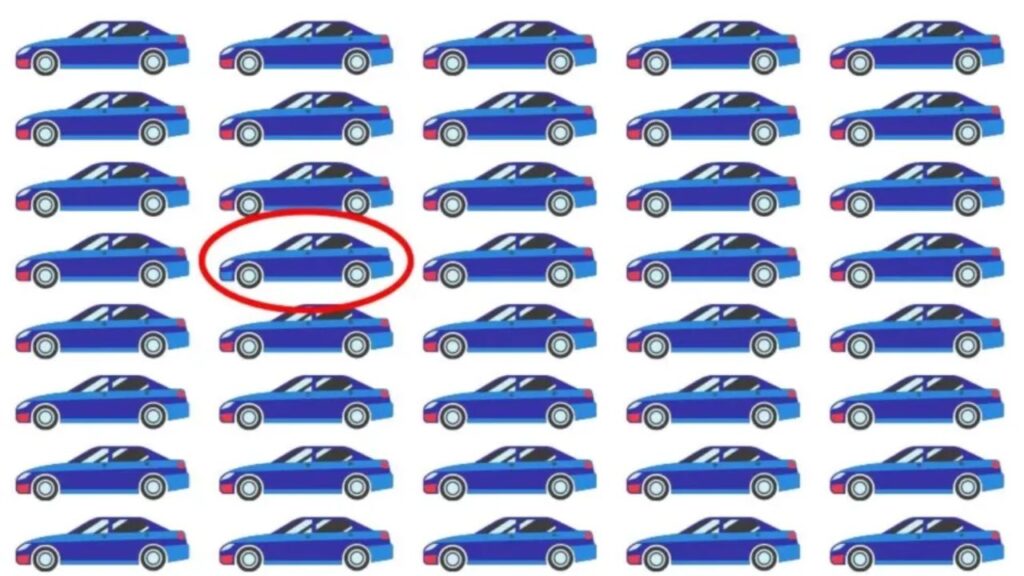The Ultimate Blue Car Challenge That’s Breaking the Internet

Social media has exploded with a new visual puzzle that’s leaving millions scratching their heads in confusion. This deceptively simple image shows dozens of blue cars arranged in neat rows, but one sneaky vehicle doesn’t belong.
The challenge seems straightforward – find the odd car out within just 23 seconds. However, thousands of people are failing this test, making successful solvers part of an exclusive 1% club.
Why This Puzzle Has Gone Viral
Car enthusiasts and puzzle lovers alike have been sharing this brain teaser across various platforms. The image has generated countless discussions about visual perception and attention to detail among online communities.
What makes this particular challenge so addictive is its apparent simplicity combined with genuine difficulty. Most people expect to solve it quickly, only to find themselves staring intently for much longer.
The Psychology of Color-Based Illusions
Our brains process color information differently than we might expect, often making assumptions based on the surrounding visual context. This natural tendency becomes the foundation for effective optical illusions involving similar hues.
Color constancy explains why our brains sometimes struggle with subtle variations in similar shades. The phenomenon causes us to perceive colors as more uniform than they are.
Understanding Visual Perception and Car Recognition
Human visual systems have evolved to recognize patterns and familiar objects quickly for survival purposes. However, this efficiency sometimes works against us when dealing with carefully crafted visual puzzles.
Cars represent one of the most recognizable shapes in modern society, making them perfect subjects for optical illusions. Our brains automatically categorize vehicle shapes, sometimes missing important subtle differences.
How Our Brains Process Repetitive Patterns
When presented with multiple similar objects, our visual system tends to group them automatically. This mental shortcut helps process information quickly, but can cause us to overlook individual variations.
Pattern recognition becomes both an advantage and a disadvantage in puzzle-solving scenarios. While it helps us identify cars instantly, it also prevents us from noticing when one doesn’t quite match.
The Role of Attention in Visual Challenges
Focused attention plays a crucial role in successfully completing visual puzzles like this blue car challenge. Many people fail because they don’t allocate their attention systematically across the entire image.
Random scanning rarely produces successful results in complex visual searches. The most effective approach involves methodical examination of specific areas rather than hoping for lucky discoveries.
Techniques for Mastering Car-Spotting Challenges
Professional puzzle solvers use specific strategies that dramatically improve their success rates on visual challenges. These techniques can be learned and applied to various types of optical illusions effectively.
The key lies in training your eyes to work more efficiently while maintaining systematic approaches to visual analysis. Random searching rarely produces consistent results in challenging scenarios.
The Systematic Grid Method
Divide the image into imaginary sections, examining each area thoroughly before moving to adjacent zones. This methodical approach ensures comprehensive coverage without missing important details accidentally.
Start from one corner and work systematically across the image in organized patterns. This technique prevents your eyes from jumping around randomly and potentially missing crucial information.
Focus on Shape and Size Variations
While colors might appear identical at first glance, subtle differences in vehicle proportions often reveal the hidden answer. Look carefully for variations in car length, height, or overall silhouette.
Size discrepancies become more apparent when you stop focusing on color and start examining geometric properties. The strange car might be slightly longer, shorter, or have different proportions than others.
Common Mistakes That Lead to Failure
Many intelligent people fail at this challenge not due to lack of ability, but because they employ ineffective strategies. Understanding these common pitfalls helps avoid them in future visual challenges.
The biggest mistake involves assuming all cars are identical except for the obvious odd one out. Sometimes the differences are much more subtle than initially expected.
Rushing Through the Challenge
Time pressure causes many people to scan too quickly, missing subtle details that would otherwise be obvious. While 23 seconds creates urgency, panicked searching rarely produces successful results.
Effective time management involves balancing thorough examination with efficient coverage of the entire image. Don’t spend too much time on any single area initially.
Ignoring Edge Areas
Most people focus on the central portion of images, often neglecting cars positioned around the borders. The strange vehicle might be hiding in these commonly overlooked peripheral zones.
Edge bias represents a well-documented phenomenon in visual search tasks. Our eyes naturally gravitate toward central areas, potentially missing important information located elsewhere.
The Science Behind Blue Color Perception
Blue represents one of the more challenging colors for creating effective optical illusions due to how human eyes process this wavelength. However, subtle variations in blue shades can still create surprisingly difficult visual puzzles.
Color perception involves complex interactions between light wavelengths, retinal cells, and brain processing centers. These interactions create opportunities for visual designers to craft challenging illusions.
Why Blue Cars Create Effective Illusions
Blue vehicles appear frequently in real-world settings, making them familiar enough that our brains process them automatically. This familiarity can work against us when subtle variations are introduced.
The automotive industry uses various shades of blue, from navy to sky blue, creating natural opportunities for confusion. Small differences in hue, saturation, or brightness can be surprisingly difficult to detect.
Cultural Associations with Blue Vehicles
Different cultures associate blue cars with various meanings, from luxury to reliability to sportiness. These psychological associations can influence how we perceive and process blue vehicle images.
Cultural conditioning affects visual processing in ways we rarely consider consciously. These subconscious influences can either help or hinder performance on visual challenges involving familiar objects.
Benefits of Regular Visual Puzzle Practice
Engaging with optical illusions and visual challenges provides numerous cognitive benefits beyond simple entertainment value. Regular practice can significantly improve various aspects of mental performance over time.
Enhanced observation skills developed through puzzle-solving transfer to many real-world situations, from professional tasks to daily activities requiring attention to detail.
Improved Focus and Concentration
Visual puzzles require sustained attention, training your brain to maintain focus for extended periods without distraction. This skill proves valuable in academic and professional environments.
People who regularly practice visual challenges report better ability to concentrate during meetings, lectures, and detailed work tasks. Their enhanced focus helps them notice important details others miss.
Enhanced Problem-Solving Abilities
Working through visual challenges teaches systematic approaches to problem-solving that apply to many other situations. You learn to consider multiple strategies when initial attempts fail.
Flexible thinking developed through puzzle practice helps in professional settings where creative solutions are necessary. Employers value workers who can approach problems from various angles effectively.
Advanced Strategies for Expert-Level Performance
Master puzzle solvers develop sophisticated techniques that go beyond basic systematic searching methods. These advanced strategies can dramatically improve performance on even the most challenging visual puzzles.
Professional quality control inspectors, air traffic controllers, and medical professionals often possess these enhanced visual skills naturally. Their careers depend on catching subtle details quickly and accurately.
The Comparative Analysis Method
Instead of looking for the odd car directly, compare adjacent vehicles systematically to identify subtle differences. This approach often reveals discrepancies that direct searching might miss completely.
Relative comparison proves more effective than absolute identification in many visual search tasks. The human brain excels at detecting differences when objects are examined side by side.
Peripheral Vision Utilization
Train yourself to use peripheral vision more effectively while maintaining central focus on specific areas. This technique allows broader coverage without sacrificing detailed examination of particular zones.
Professional drivers and pilots develop exceptional peripheral awareness through training and practice. These same skills apply effectively to visual puzzle challenges requiring broad attention spans.
The Social Aspect of Visual Challenges
Viral puzzles like this blue car challenge create shared experiences that bring people together across social media platforms. Friends and family members compete to see who can solve challenges fastest.
The competitive element adds excitement while encouraging people to develop better visual skills through practice. These social connections enhance the overall experience significantly beyond individual achievement.
Building Communities Around Puzzles
Online communities devoted to optical illusions provide platforms for sharing strategies, celebrating successes, and discussing new challenges. These groups foster learning and skill development among members.
Collaborative problem-solving emerges when community members share different approaches to the same puzzle. This knowledge sharing benefits everyone involved in the community.
Educational Value in Group Settings
Teachers and trainers increasingly use visual puzzles to demonstrate concepts related to perception, attention, and cognitive processing. These challenges provide engaging ways to explore complex psychological principles.
Interactive learning proves more effective than passive instruction for many students. Visual challenges create memorable experiences that reinforce important educational concepts naturally.
The Answer Revealed: Finding the Strange Blue Car

After careful systematic examination of the blue car arrangement, the strange vehicle can be found in the third row from the top, positioned approximately two-thirds across from the left side. This particular car has a slightly different shade of blue and altered proportions compared to surrounding vehicles.
Look specifically for the car that appears marginally darker than its neighbors with a subtly different roof line. The variation becomes more apparent once you know exactly where to direct your focused attention.
Developing Lifelong Visual Skills
Visual challenges like this blue car puzzle offer more than temporary entertainment – they provide valuable mental exercise that enhances cognitive function. Regular engagement with optical illusions improves attention, observation skills, and systematic thinking abilities.
Whether you spotted the strange car within 23 seconds or needed additional time, the important thing is participating in the challenge. Each attempt builds visual processing skills that prove beneficial in countless real-world situations throughout life.

